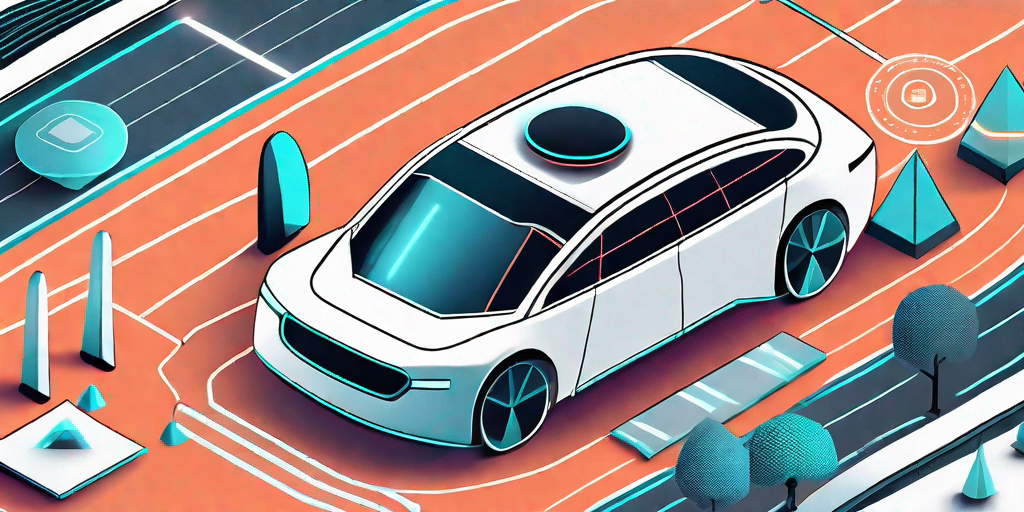Understanding Self-Driving Vehicles with an Innovation Futurist's Help

Understanding Self-Driving Vehicles with an Innovation Futurist's Help
Self-driving vehicles have become a hot topic in recent years, captivating the imagination of technology enthusiasts and transportation experts alike. With the promise of safer roads, increased accessibility, and improved efficiency, autonomous cars have the potential to revolutionize the way we travel. However, understanding the intricacies of this groundbreaking technology can be quite challenging.
Understanding the Concept of Self-Driving Vehicles
Before diving into the complexities of self-driving vehicles, let's start with a basic understanding of the concept. At its core, a self-driving vehicle, also known as an autonomous car, is a vehicle capable of navigating its surroundings without human input. Leveraging a combination of advanced sensors, artificial intelligence, and cutting-edge software, these vehicles can perceive their environment and make informed decisions based on real-time data.
Imagine a car that can analyze traffic patterns, detect obstacles, and predict pedestrians' movements, all while smoothly navigating from point A to point B. That is the essence of self-driving technology, which has the potential to revolutionize transportation as we know it.
One of the key components of self-driving vehicles is their advanced sensor systems. These vehicles are equipped with an array of sensors, including cameras, lidar, radar, and ultrasonic sensors. These sensors work together to create a detailed and accurate picture of the vehicle's surroundings.
Cameras capture visual information, allowing the vehicle to "see" the world around it. Lidar, which stands for Light Detection and Ranging, uses laser beams to measure distances and create a 3D map of the environment. Radar sensors use radio waves to detect objects and determine their distance and speed. Ultrasonic sensors, on the other hand, use sound waves to detect nearby objects.
With this wealth of sensor data, self-driving vehicles can perceive their environment in great detail. They can identify other vehicles, pedestrians, cyclists, and even road signs and traffic lights. This comprehensive understanding of the surroundings enables the vehicle to make informed decisions and navigate safely through various traffic scenarios.
But it's not just the sensors that make self-driving vehicles possible. Artificial intelligence plays a crucial role in processing the sensor data and making real-time decisions. The vehicle's onboard computer system uses complex algorithms to analyze the sensor data and generate a detailed understanding of the environment.
Through machine learning, self-driving vehicles can continuously improve their performance. They learn from their experiences on the road, constantly updating their algorithms to adapt to different driving conditions and scenarios. This iterative learning process allows the vehicles to become more proficient and reliable over time.
Another important aspect of self-driving technology is the advanced software that controls the vehicle's movements. The software takes into account the sensor data, the vehicle's current position, and its destination to plan and execute a safe and efficient route.
When it comes to safety, self-driving vehicles are designed with redundancy in mind. They have multiple backup systems to ensure that even if one component fails, the vehicle can still operate safely. This redundancy extends to the communication systems as well, allowing the vehicle to stay connected and exchange information with other vehicles and infrastructure.
As self-driving technology continues to evolve, there are still many challenges to overcome. Regulatory frameworks need to be established to govern the operation of autonomous vehicles on public roads. Cybersecurity measures must be implemented to protect these vehicles from potential hacking attempts. And public acceptance and trust in self-driving technology need to be fostered through education and awareness.
Nevertheless, the potential benefits of self-driving vehicles are immense. They can improve road safety by reducing human error, which is a leading cause of accidents. They can increase accessibility by providing transportation options for those who are unable to drive, such as the elderly or people with disabilities. And they can reduce traffic congestion and emissions by optimizing traffic flow and promoting the use of electric vehicles.
In conclusion, self-driving vehicles have the potential to revolutionize transportation by leveraging advanced sensors, artificial intelligence, and cutting-edge software. With their ability to perceive and understand their surroundings, make informed decisions, and navigate safely, these vehicles represent the future of transportation. As we continue to push the boundaries of technology, it is important to address the challenges and work towards a future where self-driving vehicles are a common sight on our roads.
Role of an Innovation Futurist in Deciphering Autonomous Vehicle Technology
Now that we have a basic grasp of self-driving vehicles, let's delve into the role of an innovation futurist in deciphering this groundbreaking technology. An innovation futurist is a visionary individual who specializes in forecasting future trends and technologies. With their unique ability to analyze emerging technologies and their potential impact on society, they provide invaluable insights into the world of autonomous vehicles.
But what exactly does an innovation futurist do when it comes to autonomous vehicle technology? Well, let's explore further. One of the key responsibilities of an innovation futurist is to stay up-to-date with the latest advancements and industry trends. They immerse themselves in the world of autonomous vehicles, attending conferences, reading research papers, and engaging with experts in the field. This constant learning allows them to paint a vivid picture of what the future of transportation may look like.
However, it's not just about staying informed. Innovation futurists also possess an intricate understanding of the technology behind self-driving vehicles. They delve into the complexities of artificial intelligence, machine learning, and sensor technologies that enable autonomous vehicles to navigate the roads. By deciphering these complex concepts, they can explain them in a way that is easily comprehensible to the general public.
Furthermore, innovation futurists play a crucial role in bridging the gap between technology and society. They act as translators, taking the jargon-filled language of engineers and transforming it into accessible information for policymakers, businesses, and the public. By doing so, they ensure that everyone can understand the potential benefits and challenges associated with autonomous vehicles.
Another important aspect of an innovation futurist's role is to anticipate the societal impacts of autonomous vehicles. They consider not only the technological advancements but also the broader implications on transportation infrastructure, urban planning, and employment. By analyzing these factors, they can provide insights into how autonomous vehicles may reshape our cities, change the way we commute, and even impact job markets.
In addition to their analytical skills, innovation futurists also possess a strong sense of creativity and imagination. They are able to envision scenarios and possibilities that may seem far-fetched to others. This imaginative thinking allows them to explore potential future applications of autonomous vehicle technology, such as delivery drones, shared mobility services, and even flying cars.
Overall, the role of an innovation futurist in deciphering autonomous vehicle technology is multifaceted. They combine their expertise in forecasting future trends, understanding complex technologies, translating technical language, and anticipating societal impacts to provide invaluable insights into the world of self-driving vehicles. As this technology continues to evolve, innovation futurists will play a vital role in shaping its future and ensuring its responsible integration into our society.
Exploring the Potential Impact of Self-Driving Vehicles
Now, let's dive deeper into the potential impact of self-driving vehicles on various aspects of our lives. One of the primary benefits of autonomous cars is the potential to significantly reduce traffic accidents. Humans are prone to errors, distractions, and fatigue, which often lead to accidents on the road. Self-driving vehicles, on the other hand, can eliminate human error, making roads safer for everyone.
Imagine a world where you can confidently step into a self-driving car, knowing that the chances of being involved in a collision are drastically reduced. With advanced sensors and artificial intelligence, autonomous vehicles can analyze the road conditions, predict potential hazards, and react much faster than human drivers. This increased safety can bring peace of mind to passengers and their loved ones, ultimately transforming the way we perceive transportation.
Additionally, autonomous cars have the potential to improve accessibility for individuals with disabilities or limited mobility. By removing the need for driving skills, self-driving vehicles can provide newfound freedom and independence to those who may have otherwise struggled with transportation options. Imagine a person with a physical disability being able to travel to work, visit friends, or explore new places without relying on others for assistance. Self-driving cars can empower individuals to live more fulfilling lives and participate more actively in society.
Furthermore, self-driving vehicles have the potential to greatly enhance the efficiency of transportation systems. With their ability to communicate and coordinate with each other, autonomous cars can optimize traffic flow, reducing congestion and minimizing travel times. Imagine a city where traffic jams are a thing of the past, where vehicles seamlessly navigate through intersections and merge lanes with precision. This improved efficiency not only saves time for commuters but also has a positive environmental impact by reducing emissions.
Moreover, self-driving vehicles can revolutionize the concept of long-distance travel. Imagine embarking on a road trip without the need to worry about driving fatigue or finding a place to rest. Autonomous cars can take over the monotonous task of driving, allowing passengers to relax, work, or engage in leisure activities during the journey. This newfound freedom can transform the way we experience travel, making it more enjoyable and productive.
Furthermore, self-driving technology can have a profound impact on the logistics and transportation industry. With autonomous trucks, goods can be transported more efficiently and reliably. These vehicles can operate non-stop, eliminating the need for mandatory rest breaks and reducing delivery times. This increased efficiency can have a ripple effect on various industries, from e-commerce to manufacturing, improving supply chain management and customer satisfaction.
In conclusion, the potential impact of self-driving vehicles is vast and multifaceted. From improving road safety and accessibility to enhancing transportation efficiency and transforming travel experiences, autonomous cars have the potential to revolutionize the way we move. However, as with any technological advancement, there are also challenges and considerations to address, such as legal and ethical implications, job displacement, and cybersecurity. As we continue to explore and develop self-driving technology, it is crucial to approach it with a balanced perspective, considering both the benefits and potential drawbacks, to ensure a future where autonomous vehicles truly benefit society as a whole.
How an Innovation Futurist Forecasts the Future of Transportation
So, how does an innovation futurist forecast the future of transportation? Their work involves a meticulous analysis of current technological trends, industry research, and real-world applications of self-driving vehicles. By combining data from various sources, they can identify potential roadblocks, predict hurdles, and speculate on the timing of widespread adoption.
However, it's important to note that forecasting the future is not an exact science. Innovation futurists must use their knowledge and expertise alongside critical thinking and intuition to envision what lies ahead. Their forecasts are based on a careful examination of the possibilities and should be regarded as educated predictions rather than absolute certainties.
The Ethical and Societal Implications of Autonomous Cars
As with any technological advancement, self-driving vehicles come with their fair share of ethical and societal implications. One of the most prominent ethical dilemmas revolves around the question of liability. In the event of an accident involving a self-driving vehicle, who is responsible for the consequences? Should the blame be placed on the vehicle's manufacturer, the software developers, or the passengers themselves?
Another concern is the potential displacement of jobs. With the rise of autonomous cars, the role of traditional drivers may become obsolete, leading to unemployment for millions of individuals reliant on driving as their primary source of income. Addressing these concerns and finding suitable solutions is crucial for a smooth transition to a future with self-driving vehicles.
Conclusion
In conclusion, understanding self-driving vehicles requires delving into the intricate details of the technology while considering the potential impact on various aspects of our lives. With the help of innovation futurists, we gain valuable insights into the future of transportation and can navigate the ethical and societal implications that arise with this groundbreaking technology. As we journey towards a future of autonomous cars, let us embrace curiosity, critical thinking, and open dialogue to shape a transportation landscape that benefits all of society.
Frequently Asked Questions
1. What is a self-driving vehicle?
A self-driving vehicle, also known as an autonomous car, is a vehicle capable of navigating its surroundings without human input. It uses advanced sensors, artificial intelligence, and cutting-edge software to perceive its environment and make informed decisions based on real-time data.
2. How do self-driving vehicles perceive their surroundings?
Self-driving vehicles are equipped with a variety of sensors, including cameras, lidar, radar, and ultrasonic sensors. These sensors work together to create a detailed and accurate picture of the vehicle's surroundings. They can identify other vehicles, pedestrians, cyclists, road signs, and traffic lights, enabling the vehicle to make informed decisions and navigate safely.
3. What are the potential benefits of self-driving vehicles?
Self-driving vehicles have the potential to revolutionize transportation in several ways. They can improve road safety by reducing human error, increase accessibility for individuals with disabilities, and enhance transportation efficiency by optimizing traffic flow. Additionally, self-driving technology can have a profound impact on industries such as logistics and transportation, improving supply chain management and customer satisfaction.
Contact a Innovation Futurist for your event
Are you looking to bring a visionary perspective to your next event? Dr Mark van Rijmenam, a renowned Innovation Futurist, is available to share his expertise in autonomous vehicle technology and the future of transportation. With his unique ability to decipher complex concepts and forecast future trends, Dr van Rijmenam can provide your audience with invaluable insights into the world of self-driving vehicles. His engaging presentations not only help to understand the intricate details of this groundbreaking technology but also explore its potential societal and ethical implications. Let Dr van Rijmenam take your event to the next level with his thought-provoking insights and foresight. Simply complete the form below, and we will be in touch within 24 hours to discuss how Dr van Rijmenam can bring a futuristic edge to your event.





